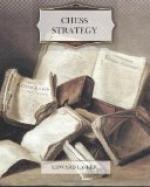I shall now give a few games showing the far-reaching consequences of losing moves. The first one is a typical though glaring example, which is very instructive and came to my notice some time ago:
1. P-K4 P-K4 2. P-Q4 PxP 3. QxP Kt-QB3 4. Q-K3 Kt-B3 5. P-KR3?
I will not discuss the system of development adopted by White in his first four moves. The last move, however, can at once be recognised as faulty. It is the loss of a move such as occurs in the vast majority of games played by beginners. It was unnecessary to prevent KKt-Kt5, since the Knight could not hold that square permanently. In any case B-K2 would have had the same effect, and developed a piece at the same time.
5.
... B-K2
6.
P-QR3??
This, of course, is very bad. The consequences of this loss of a second move are swift and deadly.
6.
... Castles
7.
B-B4
At last a developing move.
7.
... R-K1
8.
Q-QKt3
Another Queen’s move. The attack on the Bishop’s Pawn may be very tempting, but must necessarily be incorrect—and why? Because White is much behind with his development. It is useless to analyse any kind of attack in face of this fact. The beginner finds it hard to get used to this way of thinking. He prefers to try to unravel a long string of variations and combinations, in which he will mostly lose his bearings. Even stronger players obstruct their own powers by refusing to see the value of judging a position on general merits. They lose valuable time in thinking out endless variations, to maintain positions which could be proved valueless by general and logical deductions.
--------------------------------------- 8 | #R | | #B | #Q | #R | | #K | | |---------------------------------------| 7 | #P | #P | #P | #P | #B | #P | #P | #P | |---------------------------------------| 6 | | | #Kt| | | #Kt| | | |---------------------------------------| 5 | | | | | | | | | |---------------------------------------| 4 | | | ^B | | ^P | | | | |---------------------------------------| 3 | ^P | ^Q | | | | | | ^P | |---------------------------------------| 2 | | ^P | ^P | | | ^P | ^P | | |---------------------------------------| 1 | ^R | ^Kt| ^B | | ^K | | ^Kt| ^R | --------------------------------------- A B C D E F G H
Diag. 15
Then, as in the present position, retribution comes swiftly.
8. ... P-Q4
White should have considered this move. It was obvious, since the opening of the K file for the Rook is most dangerous, for the White King.
9. BxP KtxB
Black could have played QxB at once.




